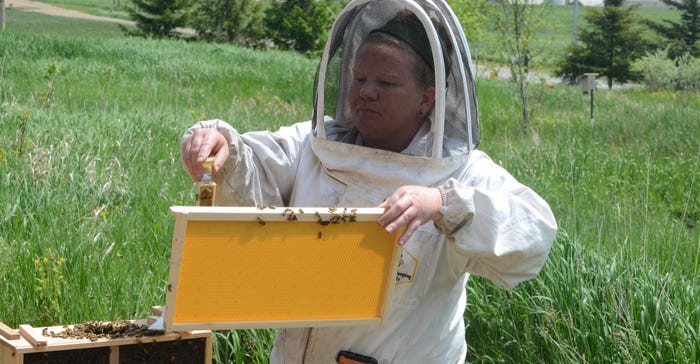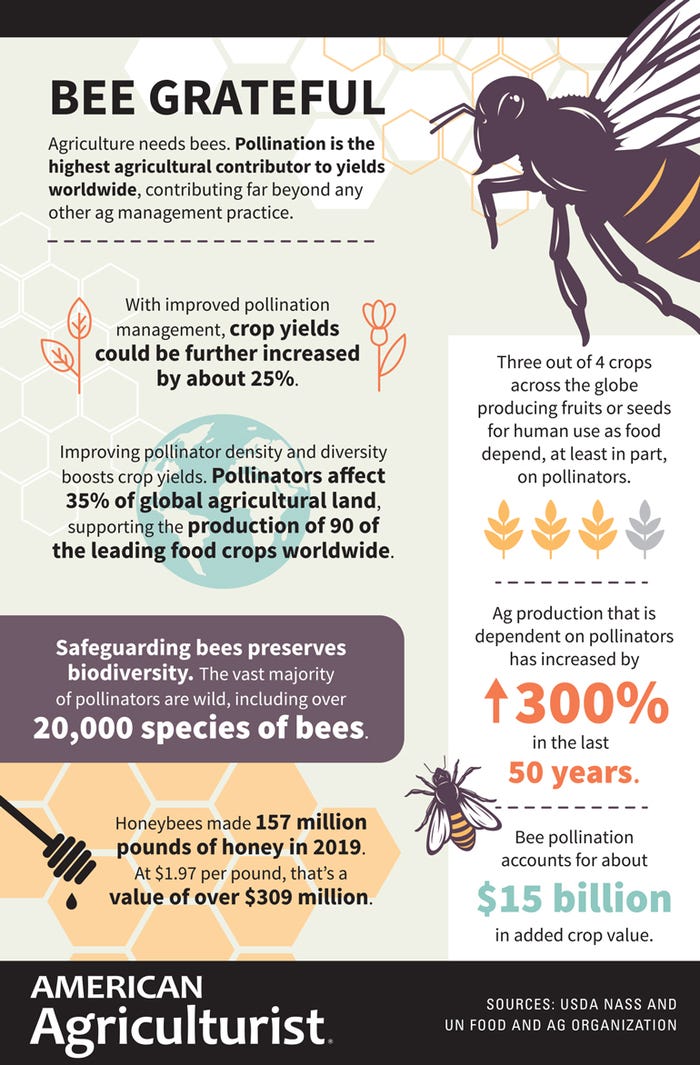
She calls herself a “honey girl,” having a love of all things related to honeybees and the goodness they produce.
When Genji Leclair moved from Chicago to Fremont, Mich., a few years ago, she knew her life would be different. Just how different started to unfold the day she bought a jar of Hasselman Honey.
“It was amazing, and on the jar it said, ‘Local Honey — Call Larry,’ with his phone number, so I did,” Leclair says. “Larry Hasselman was the owner, and I asked him all kinds of questions about his honey and if I could visit his honey barn.”
She did just that and proceeded to get “hands-on” by helping him pour jars of honey. One visit ended up being two and three, and so on. “I could tell he was having trouble keeping up with everything, so I helped him more and more, and he helped me set up beehives on my property,” Leclair recalls.
Hasselman mentored her for a couple of years before he retired, and she took over the honey production and started Great Lakes Bee Co. with her husband, Steve, and daughter, Lauren Kelly. In addition to selling more than 150,000 pounds of honey each year under the Hasselman name, GLBC also offers beeswax products, and the bees are rented out to help pollinate various crops, including almonds (January in California), apricots, sweet cherries, peaches and plums (April); tart cherries, pears, blueberries and apples (May).
Honeybee pollination critical
Bees play a big role in agriculture. They pollinate crops, increase yields and give rise to a lucrative honey industry. Dinner plates across the world would look quite bare without honeybees, as about one-third of the food eaten by Americans — from nuts to fruits and vegetables — comes from crops pollinated by honeybees, USDA reports.
Commercial production of more than 90 crops rely on bee pollination, which accounts for more than $15 billion in annual U.S. agricultural production and $217 billion worldwide, according USDA’s National Agriculture Statistics Service. That’s in addition to 157 million pounds of honey produced in 2019 with a value of a little over $309 million.

“Larry’s honey tradition continues,” says Leclair, who takes pride in also helping new and expanding beekeepers. Not only is she bottling and marketing Newaygo County honey — which comes from a unique blend of alfalfa, clover, basswood, star thistle and West Michigan wildflowers — she’s also fostering the love of beekeeping by supplying bees, queens and nucleus boxes, or “nucs.”
Honeybees grow in large colonies that can be split to make more. Nucs are frames of comb removed from an established hive that contain comb with a developing brood at several stages of development. In most cases, they also contain cells with honey and pollen stored by the original colony. “Larry always sold bees, so we wanted to continue that,” Leclair says.
Inside the wooden frame is a foundation, where bees draw out comb and place honey and pollen and where the queen lays eggs, Leclair adds.
Buying bees
Two Saturdays in May, beekeepers lined up in Fremont to buy nine-frame boxes with Hasselman Honey legacy bees, tended by beekeeper Jeff Green. They were shipped from the state of Georgia, where the bees were basking in the warmth during Michigan’s winter chill, which can kill a hive.
Also, five-frame nucs were available, sourced from an Amish beekeeper in northern Wisconsin.
Other bees were sourced from a large apiary in Georgia with smaller bee packages, which is a wooden frame box with a screen on two sides. Three-pound packages equate to about 10,000 bees and a separate queen, who goes through a process to be accepted by the bees. During demo day May 22, buyers could learn how to introduce bees to a vacant hive box and also how to use smokers.
Mark and Beth Meachum of Charlotte, Mich., bought a 3-pound package to repopulate a vacant hive that had died.
“I was introduced to beekeeping by my dad, and I had as many as seven hives, but only two now,” says Mark, who adds that it’s a balance between a hobby and a business for him. He expects his purchased bees will produce about 30 pounds of honey a year that he generally gives away in the form of honeycomb. “Bees are pretty incredible, and I marvel at God’s creation,” he says.
Considerations and support
For those considering becoming a beekeeper, Leclair says to check with your neighbors and make sure there is a plentiful food source nearby. “If the answers to those are yes, then do it!” she says. “Just know it costs about $500 for equipment, supplies and bees in your first colony, and you’ll need to check on your bees once every week or two. After that, if you do your own splits, you can continue to grow hives and let the bees do the work of growing new colonies for you.”
Honeybees do face threats to their health, though, including parasites, pathogens, loss of habitat and pesticides. Each pose a risk to killing honeybee colonies.
Even so, Leclair says she excited to see an uptick in what she calls “backyard beekeepers.”
“I think education is the most challenging aspect — underlining the importance of bees, the health benefits of the products the hive produces and how to take care of bees and not be afraid of them,” she says. “They don’t want to sting you because it kills them, but they will if they feel the hive is threatened.”
For those wanting to support honeybees, but not interested in becoming a beekeeper, Leclair says to plant seed mixes that support distinct blooming cycles of plants benefiting pollinators, which help to create healthy environments for honeybees — and other pollinators such as butterflies, moths, beetles, flies and wasps.
Whether it’s a vineyard, orchard, livestock ranch or commodity crop farm, there is a lot of opportunity for any agricultural system, Leclair says, to integrate pollinator habitats without disrupting the production of their main enterprise.
Recognizing this need for habitat, USDA’s Conservation Reserve Program is offering the Pollinator Habitat Planting Initiative that rewards participants of newly enrolled pollinator habitat practices on eligible land with:
10 years of annual rental payments
payments covering 50% of the eligible costs of establishing the practices
50% from a cost-share payment
a sign-up incentive payment up to $150 per acre
For more information, on the CRP program, contact your local conservation office or visit the USDA Farm Service Agency website at offices.usda.gov.
For more information on GLBC, visit thegreatlakesbeecompany.com. The Northern Bee Network at northernbeenetwork.org is a free directory for beekeepers in the U.S. looking to buy, sell or trade local queens or nucs. The Pastures for Pollinators website offers information on planting pollinator habitat and a blooming chart of common cover crop species.
About the Author(s)
You May Also Like






